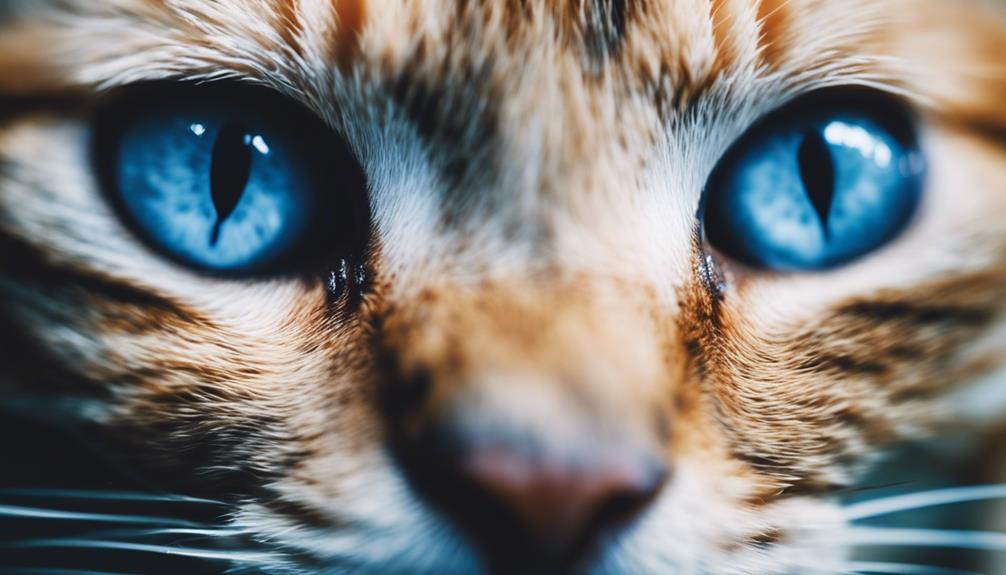When studying cat emotions through pupil size, dilated pupils show excitement or fear, while narrowed ones suggest anger or readiness to attack. Half-closed eyes alongside normal pupils indicate relaxation and contentment. Fear and anxiety may be signaled by dilated pupils or wide-eyed anxiety cues. Pupil size even reveals pain perception and potential medical conditions, urging timely veterinary attention. Understanding these cues grants valuable insights into your feline's well-being. By observing their pupils, we gain a deeper understanding of our cats' feelings. Discover more about deciphering your cat's emotions through their pupils for a richer connection with your feline companion.
Key Takeaways
- Cat's pupil size reflects emotions like fear, excitement, and aggression.
- Dilated pupils indicate anxiety or distress in cats.
- Half-closed eyes with normal pupils show relaxation and contentment.
- Pupil size variations can reveal pain perception in cats.
- Abnormal pupil sizes can indicate underlying medical conditions in cats.
Cat Pupil Size and Emotions
When observing a cat's pupil size, it becomes evident that it serves as a clear indicator of the feline's current emotional state. Cats rely heavily on their eyes to communicate, and pupil sizes play a vital role in understanding their feelings. Dilated pupils in cats can signal excitement, fear, or overstimulation, while narrowed pupils often indicate anger, aggression, or readiness to attack.
On the other hand, half-closed eyes paired with normal pupil size suggest relaxation and contentment, portraying a calm demeanor in cats. When cats have wide eyes with dilated pupils, it typically means they're alert and fully engaged in their surroundings.
Understanding these subtleties in cat body language can help us better comprehend our feline companions' emotions and respond accordingly. By paying attention to their eyes and pupil sizes, we can gauge their mood and provide appropriate support and care. Anisocoria, characterized by uneven pupil sizes, shouldn't be overlooked, as it could signify underlying health issues that require immediate attention.
Cats' eyes truly are windows to their souls, offering valuable insights into their well-being and emotional states. Their pupils can dilate or contract depending on their mood, ranging from excitement and curiosity to fear or aggression. In many cultures, cats’ eyes have been associated with sun and moon symbolism, reflecting their connection to both day and night, light and shadow. This mystical quality only adds to their enigmatic nature, making them revered companions throughout history.
Fear and Anxiety Indicators

Indicating fear and anxiety in cats, dilated pupils serve as essential markers of their emotional distress. When a cat experiences fear or anxiety, their pupils can dilate to let in more light, enhancing their ability to detect potential threats.
Wide-eyed with dilated pupils, a cat may appear alert and engaged, but this could also signal underlying anxiety. In more severe cases, massive, nearly-black pupils may indicate overstimulation or high levels of anxiety.
Cats with dilated pupils might exhibit behaviors like hiding, hissing, or being on edge, showing their emotional turmoil. Recognizing these pupil size changes is crucial for understanding and addressing fear and anxiety in cats.
Relaxation and Contentment Signs
Relaxed cats typically exhibit half-closed eyes and normal pupil size as signs of contentment and relaxation. When a cat is content and at ease, you may notice their eyes appearing partially closed, giving off a serene vibe. This relaxed state is often accompanied by a normal dilation of the pupils, neither too constricted nor overly dilated.
In addition to the eyes, a cat displaying contentment might also have a relaxed posture and may even be purring softly. These physical cues signal that your feline friend is feeling comfortable and trusting of their environment. Observing these signs can provide valuable insights into your cat's emotional state, allowing you to respond appropriately to maintain their sense of well-being.
Pupil Size and Pain Perception

To understand a cat's potential pain or discomfort, observing their pupil size can provide valuable insights into their well-being and health status. Cats' eyes can help us understand their non-verbal communication, as changes in pupil size can indicate pain or distress. Dilated pupils in cats may suggest heightened sensitivity and discomfort, potentially signaling underlying health issues. Monitoring variations in pupil size is vital, as it can assist in detecting possible illnesses when paired with other symptoms. Cats tend to hide pain, but their pupils can reveal their discomfort levels. If a cat consistently shows dilated pupils, it is important to contact your vet right away. Consulting a veterinarian is essential in such cases, as chronic pain or medical conditions may be the underlying cause. By paying attention to their pupil size and seeking prompt veterinary care, we can make sure our feline companions receive the necessary treatment and support.
| Key Points | Details |
|---|---|
| Cats' Pupil Size | Reflects pain perception and discomfort levels. |
| Importance of Monitoring | Helps detect underlying health issues early. |
| Veterinary Consultation | Essential if cat consistently shows dilated pupils, indicating potential chronic pain. |
Medical Conditions Revealed Through Pupils
Detecting medical conditions in cats can be essential through abnormalities in their pupil sizes. When observing a cat's eyes, any noticeable differences in pupil sizes could indicate underlying medical issues that require prompt attention. Some medical conditions that can be revealed through abnormal pupil sizes include:
- Anisocoria: Uneven pupil sizes, a condition that may signal serious health concerns such as uveitis, toxoplasmosis, or even cancer.
- Unresponsive Pupils: Fully dilated and unresponsive pupils in cats can be a sign of high blood pressure or other severe complications that necessitate immediate veterinary evaluation.
- Consequences of Untreated Abnormal Pupil Sizes: If left untreated, abnormal pupil sizes in cats can lead to blindness or other significant health consequences. Hence, it's important to seek veterinary attention if any irregularities in pupil size are noticed, as early detection and intervention can be key to managing and treating potential medical conditions effectively.
Enhancing Cat Care Through Pupil Observation

Observing cat pupil size changes enhances our ability to provide excellent care for our feline companions. Cat body language is an essential aspect of understanding our pets' emotional states. Pupil size can reveal a lot about how a cat is feeling – from relaxation to fear, excitement, or even aggression. Dilated pupils often indicate heightened alertness or a fear response, while narrowed pupils may suggest pleasure.
Fully dilated pupils, on the other hand, could signal overstimulation. As cat caregivers, being attuned to these subtle cues can help us assess and respond to our cat's emotional needs effectively. By monitoring changes in pupil size, we can gain valuable insights into our cat's well-being and mood.
This observational skill allows us to tailor our care routines to better support our feline friends, ensuring they feel safe, comfortable, and understood in our homes.
Frequently Asked Questions
Does Cat Pupil Size Mean Anything?
Cat pupil size definitely means something significant. It can reveal a range of emotions in felines, from relaxation to fear.
Dilated pupils often indicate excitement or perceived threats, while half-blinks and narrowed eyes show trust and affection. Keep an eye out for abnormal sizes like anisocoria, which might signal health issues.
Monitoring changes in pupil size can give insights into your cat's well-being and potential medical concerns.
Do Cats Pupils Dilate When They Love You?
When cats love us, their pupils may not always dilate. Pupil size reflects their emotional state, not just affection. Dilated pupils can indicate excitement or fear, not just love.
Cats show love through various behaviors like slow blinking or purring. Understanding their body language alongside pupil size is key to interpreting emotions accurately.
While dilated pupils can show playfulness, they can also signal anxiety. So, looking at the whole picture helps decipher our feline friends' feelings.
Do Cats Pupils Change With Emotion?
Yes, cat pupils change with emotions such as excitement, fear, aggression, relaxation, and alertness. Dilated pupils indicate heightened arousal or stress, while narrowed ones may signal pleasure, anger, or aggression.
Half-closed eyes with normal pupils show relaxation and contentment. Understanding these changes helps interpret a cat's emotional state accurately.
It's essential to pay attention to these cues to better understand and respond to our feline companions.
Do Cats Show Emotions Through Their Eyes?
Yes, cats do show emotions through their eyes. The size of a cat's pupils can reveal a lot about how they're feeling. From relaxation to fear, their eyes speak volumes. Understanding these visual cues helps us connect better with our feline companions, ensuring their well-being and happiness.
Paying attention to their eyes is key in deciphering their emotional states and responding appropriately to their needs.
Conclusion
To sum up, when evaluating a cat's pupil size, it can offer valuable insights into their emotions, health, and well-being. By being mindful of changes in pupil size, we can gain a better understanding of our feline companions and provide them with the necessary care.
Whether it's identifying signs of fear, anxiety, relaxation, or even medical conditions, monitoring pupil size can assist us in enhancing our cat's quality of life. So the next time you gaze into your cat's eyes, remember to contemplate what their pupils might be conveying to you.











